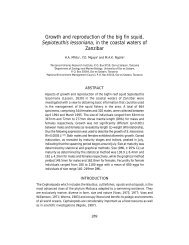gpa_east_africa_case.. - GRID Africa GeoPortal - UNEP
gpa_east_africa_case.. - GRID Africa GeoPortal - UNEP
gpa_east_africa_case.. - GRID Africa GeoPortal - UNEP
You also want an ePaper? Increase the reach of your titles
YUMPU automatically turns print PDFs into web optimized ePapers that Google loves.
Dose-response data are not available to show the sensitivity of fisheries production toincreased levels of pollution. It is therefore assumed that, if half of the output is immediately atrisk, the fisheries cost of pollution (and the value of benefits from avoided losses andexcluding future growth of output) is roughly 3.0 $ million a year.3. Human healthAt present, there is little evidence of health problems associated with contamination due tosewage discharge in the Beau Vallon area. It is therefore difficult to estimate health costs onthe basis of national data. Assumptions have to be made therefore. In the event of a choleraepidemic in Seychelles (as it was assumed in a recent study for Mauritius in the context ofthe Montagne Jacquot Sewerage System), say by the year 2002/2003, until the seweragesystem become operative, it would reduce tourism arrivals by at l<strong>east</strong> 10% below the "withproject" scenario. Assuming a conservative 5% reduction per annum due to generalenvironmental degradation but without major diseases such as cholera that would destroytourism in Seychelles, would amount to a decline of tourist arrivals from 50,000 in 2003 to21,000 in 2020. A 10% annual decline would bring it down to zero. It should be noted that astudy of the impact of cholera in Peru in 1991 showed the decline of gross tourism earningsdue to cholera epidemic to range between 6-28%.A more realistic estimate of possible health impacts may be based on the treatment costs andwork-days lost. If 20% of the 2010 population (8,500 x 0.20 = 1,700) are affected by somewater-borne diseases once a year, requiring 15 days absence from work and a low $15treatment cost per day, the cost may be estimated as follows: The cost of treatment atapproximately $382,500 per year (15$ x 1,700 x 15) and the cost of loss of employmentincome approximately at $510,000 per year (20$ x 1,700 x 15), totalling US$ 892,500 ayear. This cost excludes the human distress and pain which are not quantified. They arequalitative impacts.4. Property valuesThere are at present about 1,555 housing units in Beau Vallon (7,000 population / 4.5 = 1,555units on 155 ha –10 units ha). Total building land is assumed to be a third of the total landarea, that is 1,100 ha / 3 = 366 ha. Therefore, the available land area for development overthe next 10 years is estimated at 211 ha (366 ha stock minus 155 already developed). Of this,35 ha will be developed in the next 5 years and another 35 ha assumed for the following 5years, leaving 141 ha as open space or for long-term needs. If the average value of the 1,555existing housing units is about $ 75,000, a10% reduction of that value due to proximity to apotentially polluted part of the coast or river, the annual loss of value would be $ 11.6 million(75,000 x 1,555 x 0.10). This value would represent the annual cost to properties in areaspresently at risk (in terms of foregone value increment) and, equally, the expected benefit toaccrue from the sewerage infrastructure which will serve them. Similarly, the estimated valueof the 70 ha of development land for the next 10 years may be in the region of about $26.2million, assuming a density of 10 units per ha and an average value of $37,500 per plot, beinghalf the value per developed plot with housing on it (70x10x$37,500). 10% of that would be$2.6 million of additional benefit to property, totalling an estimated annual amount of $14.2million, without counting the 141 ha for open space.Indirect Costs5. RecreationThere is no information on the social valuation of recreation opportunities to the localpopulation. Such valuation would reflect the indirect benefit from the “services” ofenvironmental quality for which there are no market prices to record it even approximately.However, recreational benefits are as real and important as direct benefits and cannot simplybe ignored. In the absence of any information on how many people visit coastal or marineparks and indications of proxy prices, such as entrance fees or travel costs, it is reasonable toclassify this source of benefit as qualitative.To estimate recreation benefits would ideally involve calculations of how much people wouldbe willing to pay to have access to recreation areas of a certain level of quality, requiring asurvey of social preferences.Final Draft Report – Cost Benefit Case StudiesGPA Strategic Action Plan on Sewage, October, 200052



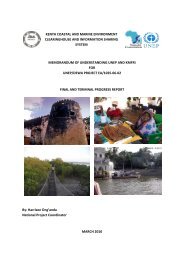
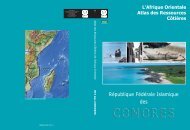
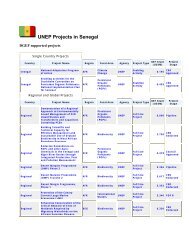

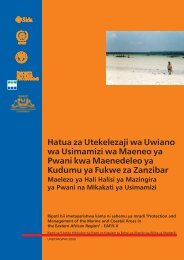
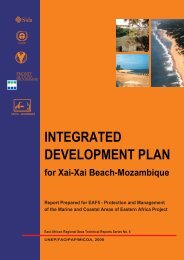
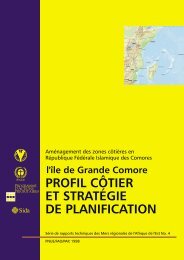
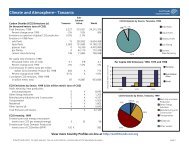

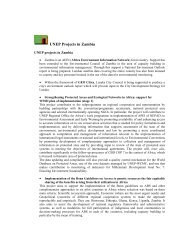
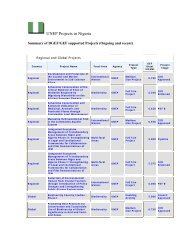
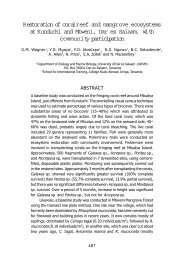
![Please Click to download [English] - GRID Africa GeoPortal - UNEP](https://img.yumpu.com/30633391/1/184x260/please-click-to-download-english-grid-africa-geoportal-unep.jpg?quality=85)
